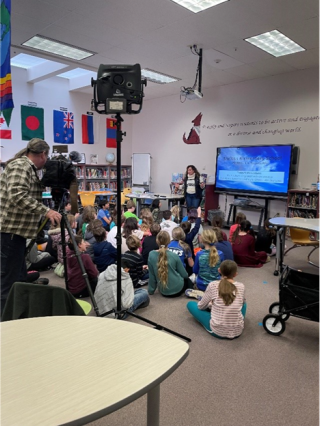Inspiring Students to Tackle Environmental Challenges
Like so many people, my days routinely consist of back-to-back meetings, jumping from calls to my inbox, then right back into more meetings. It’s so easy to get bogged down with work instead of spending valuable time in the communities we serve. This was on my mind when two letters came across my desk from local fifth graders who were expressing concern about our air in Colorado.
Instead of just writing them a letter back, I took this opportunity to enlist the help of my environmental education and air experts to meet with them in person and talk to these students and their classmates about air quality. On a cold, snowy day in January, I stood in front of 70 students to discuss air quality and what it means for their health and their future.
The Importance of Children’s Health
Children breathe more air, drink more water, and eat more food per pound of body weight than adults.
Children are particularly vulnerable to certain environmental risks, including air pollution.
Their bodies are not the same as adult bodies, and they depend on adults to ensure that their environment is safe. One of EPA’s most important goals is to ensure that our actions and programs protect children where they live, learn and play.
I wanted to make sure that our visit was more impactful that just showing up and answering questions. By sharing our knowledge and enthusiasm for the environment, we can excite children about environmental protection and empower them to be leaders for change.
Having an Impact Long After the School Visit
Our EPA staff worked closely with Shelton Elementary teachers to enroll them in EPA’s Air Quality Flag Program so the students could continue to raise awareness and take action long after our visit to the school. We brought the air quality flags with us and used a hands-on activity to challenge the students to demonstrate their knowledge of air quality based on the colors used in EPA’s Air Quality Index: green, yellow, orange, red, and purple. These students were already so knowledgeable, and very eager to participate! They had a lot of questions for us - ranging from how plant life affects our atmospheric oxygen, and how volcanoes can have positive and negative effects on our environment to even how wildlife, such as whales, have control over our atmosphere. We capped off our visit by heading outside to hang a green air quality flag on the school’s flagpole to show that it was a good air quality day.
The Power of Children in Instigating Change
Because children will inherit the Earth, they have a big stake in environmental protection. It is in our best interest to invest in our youth and enlist their help with environmental stewardship efforts. By sharing our knowledge and enthusiasm for the environment, we can educate children about environmental protection and empower them to be leaders for change, including teaching and influencing their parents. Each change in habit, no matter how small, can make an impact so I wanted to make sure that our visit left an impression and helped encourage lasting change in the Earth’s youngest environmentalists.
It was heartwarming to see how a simple, two-hour visit could mean so much and make a tremendous impact. During our time together, I heard some students express that they didn’t think EPA would respond to their letters, let alone come for an in-person visit! I am extremely grateful to the teachers at Shelton Elementary in Golden, Colorado, for giving us the opportunity to help immerse their fifth grade students in real world issues that transcend classroom walls. This experience was a good reminder for me that throughout my daily work at EPA, I can look for new and different ways to engage and connect with our stakeholders…of all ages.

About the Author
KC Becker
Regional Administrator
EPA Region 8
KC Becker is a passionate public servant with over 18 years of experience in both federal and state organizations. She was appointed as the Regional Administrator for EPA’s Region 8 office on November 29, 2021.
KC graduated from the College of William and Mary with a with a B.A. in Government and earned her J.D. from Lewis and Clark Law School with a certificate in environmental law, where she served on Law Review. She also earned an M.S. in Real Estate Development from the University of Denver’s Daniels College of Business. Before and during law school, she worked for environmental and outdoor organizations, and camped throughout the western U.S.
Other than working to improve the quality of the environment, she likes to read, ski and hike. KC lives in Boulder, Colorado with her husband and two sons.
Editor’s Note: The views expressed here are intended to explain EPA policy. They do not change anyone’s rights or obligations. You may share this article. However, please do not change the title or the content, or remove EPA’s identity as the author. If you do make substantive changes, please do not attribute the edited title or content to EPA or the author.
EPA’s official web site is www.epa.gov. Some links on this page may redirect users from the EPA website to specific content on a non-EPA, third-party site. In doing so, EPA is directing you only to the specific content referenced at the time of publication, not to any other content that may appear on the same webpage or elsewhere on the third-party site, or be added at a later date.
EPA is providing this link for informational purposes only. EPA cannot attest to the accuracy of non-EPA information provided by any third-party sites or any other linked site. EPA does not endorse any non-government websites, companies, internet applications or any policies or information expressed therein.



